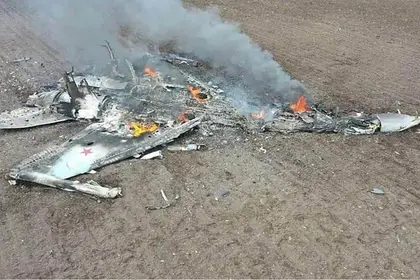On Friday Ukraine’s elite 3rd Assault Brigade, covered the withdrawal of Kyiv’s 110th Mechanized Brigade from Avdiivka, after a most brutal four-month battle. It seems likely that early the next morning the Russian air force was preparing a coup de grâce against the Ukrainian troops as they reorganized themselves.
As three of its aircraft, two Sukhoi Su-34 fighter-bombers and a Sukhoi Su-35 defense fighter, lined up for a bombing run they suddenly fell off the radar.
JOIN US ON TELEGRAM
Follow our coverage of the war on the @Kyivpost_official.
Ukrainian air force commander Lt. Gen. Mykola Oleshchuk reported on Saturday afternoon, via the Ukrainian Ministry of Defenses X (formerly Twitter) channel, that the aircraft had been shot down (by unidentified air defense weapons).
He followed this up 90 minutes later with a post on the Telegram channel that included a screenshot of a digital map, produced by the international satellite search and rescue system, Cospas-Sarsat, showing the location of the Russian crews’ emergency beacons to back up the claim. “You can see, the system works!” Oleshchuk wrote.
Early on Sunday morning he took to social media again to announce another success: ironically declaring that at “around 6:00 a.m. – another Su-34 ‘successfully returned’ to its base!”
As Kyiv Post reported at the time, video posted on X showed an aircraft reported to be the same Russian Su-34, crashing near the village of Dyakove in the Luhansk region.

Russia Launches 120 Missiles, 90 Drones in Sunday Attack on Ukraine – Zelensky
Then on Monday, just before midday reports started to appear on Ukrainian social media indicating that two more Russian aircraft, a Sukhoi Su-34 and a Sukhoi Su-35, had been shot down over the eastern front.
These three incidents exemplify how, despite being undoubtedly mismatched in terms of air superiority, Ukraine’s armed forces have again demonstrated their strategic defense capability to target and bring down Russian military aircraft, when they expose themselves – and not for the first time.
On May 13 last year, a Russian air force strike package took off from bases in western Russia and approached the border with Ukraine in the area of Bryansk. Within minutes at least four, possibly five, Russian aircraft were shot out of the sky: two Mi-8 helicopters, one Su-35 fighter jet and one Su-34 fighter bomber.
Over the course of three days, in December 2023 Ukrainian air defenses shot down five Russian aircraft: four Su-34 fighter-bombers and a multirole Su-30 as they attempted to support attacks on Ukraine’s southern front, over the Donetsk region and the Black Sea.
Credit for both the May and December successes were given to US Patriot missiles. The Institute for the Study of War reported that in response to both successes the Russian air force had further restricted its operations.
President Zelensky said that the ability to shoot down Russian fighters is a key aspect for securing a positive conclusion to the war, saying at the time:
“This week, once again, we demonstrated how effective strengthening our air shield is. It’s not just for protecting cities and villages from Russian drones and missiles, but also for frontline operations,” he said.
Zelensky also expressed gratitude to Ukraine’s partners: “The ability to shoot down Russian fighters is one of the keys to ending this war, to bringing it to a just end. And I thank all the partners who are already helping us with this and who are preparing to take appropriate steps to support us next year.”
Despite the superior numbers Russian aerospace forces enjoy, its inability to completely dominate the battle area exemplifies both the tenacity of Ukraine’s forces and the impact of Western air defense weapons. This is acknowledged by international observers, including Professor Justin Bronk who applauded the positive impact of air defense on Ukraine’s resistance in a recent Royal United Services Institute (RUSI) article.
Bronk argues that, while these aerial victories act as an effective deterrent to the wider use of Russian air assaults, they can only be sustained by the continued supply of air defense weapons.
He contends that if Ukraine is to stand any chance of eliminating Russia’s air superiority it needs advanced fighter jets such as the US F-16. The arrival of the aircraft, first promised for “spring 2024,” is now more likely to be in June, according to Lithuanian Defense Minister Arvydas Anušauskas speaking at the recent Munich Security Conference as quoted by Foreign Policy.
In 2021 Bronk argued that modern strategists placed what he called “an unhealthy, dependency on airpower,” which he said had resulted from the false lessons learned in the 1991 First Gulf War because “the US Air Force and the coalition [were able] to clear the skies and then really smash the Iraqi forces.”
Moscow had tried this tactic in the early days of the full-scale invasion, but soon discovered their aircraft could not survive in the hostile environment created by both Soviet-era and modern air defenses. Hopefully the events of last weekend have reinforced that assessment and the air threat over the front lines will remain minimized – until the F-16s appear.
You can also highlight the text and press Ctrl + Enter






